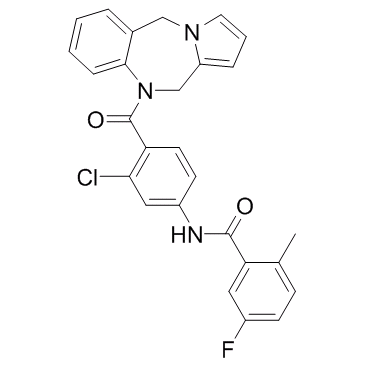Lixivaptan (VPA-985) (Synonyms: VPA-985, WAY-VPA-985) |
| Catalog No.GC32453 |
Lixivaptan (VPA-985) (VPA-985, WAY-VPA 985) is an orally active and selective vasopressin receptor V2 antagonist, with IC50 values of 1.2 and 2.3 nM for human and rat V2, respectively.
Products are for research use only. Not for human use. We do not sell to patients.

Cas No.: 168079-32-1
Sample solution is provided at 25 µL, 10mM.
Lixivaptan (VPA-985, WAY-VPA 985) is an orally active and selective vasopressin receptor V2 antagonist, with IC50 values of 1.2 and 2.3 nM for human and rat V2, respectively.
Lixivaptan displays competitive antagonist activity at V2 receptors[1].
In conscious dogs, water-loaded with 30 mL/kg (po) and arginine vasopressin (AVP)-treated (0.4 µg/kg in oil, sc), lixivaptan (1, 3, and 10 mg/kg po) increases Uvol over the AVP-treated vehicle group by 438, 1018, and 1133%, respectively, while Uosm decreases from 1222 mOsm/kg (water-loaded and AVP treated vehicle) to 307, 221, and 175 mOsm/kg, respectively. In homozygous Brattleboro rats lacking AVP, lixivaptan at 10 mg/kg po (i.e., 10 times the dose producing V2 antagonist activity) b.i.d. for 5 days, shows a sustained antagonist action without evidence of agonist effects. In a randomized double-blind placebo-controlled ascending single dose study, patients (deprived of fluids overnight before dosing) are dosed orally with 30, 75, or 150 mg of lixivaptan. All three doses increase urine flow and serum sodium concentrations and produced significant dose-related decreases in urinary osmolality[1]. Phase II clinical trials in patients with congestive heart failure, liver cirrhosis with ascites or syndrome of inappropriate antidiuretic hormone have demonstrated that lixivaptan increases water clearance without affecting renal sodium excretion or activating the neurohormonal system[2].
[1]. Albright JD, et al. 5-Fluoro-2-methyl-N-[4-(5H-pyrrolo[2,1-c]-[1, 4]benzodiazepin-10(11H)-ylcarbonyl)-3-chlorophenyl]benzamide (VPA-985): an orally active arginine vasopressin antagonist with selectivity for V2 receptors. J Med Chem. 1998 Jul 2;41(14):2442-4. [2]. Ghali JK, et al. Lixivaptan, a non-peptide vasopressin V2 receptor antagonist for the potential oral treatment of hyponatremia. IDrugs. 2010 Nov;13(11):782-92.
Average Rating: 5 (Based on Reviews and 37 reference(s) in Google Scholar.)
GLPBIO products are for RESEARCH USE ONLY. Please make sure your review or question is research based.
Required fields are marked with *




















